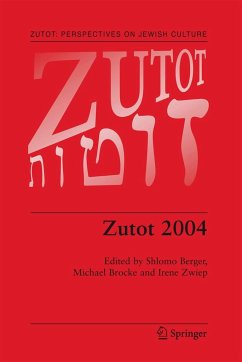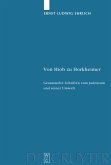S. Berger / M. Brocke / I.E. Zwiep (eds.)
Zutot 2004
Herausgegeben von Berger, Shlomo; Brocke, M.; Zwiep, I.E.
S. Berger / M. Brocke / I.E. Zwiep (eds.)
Zutot 2004
Herausgegeben von Berger, Shlomo; Brocke, M.; Zwiep, I.E.
- Gebundenes Buch
- Merkliste
- Auf die Merkliste
- Bewerten Bewerten
- Teilen
- Produkt teilen
- Produkterinnerung
- Produkterinnerung
The yearbook Zutot serves as a platform for small but incisive contributions on Jewish Studies. It covers Jewish Culture in its broadest sense, encompassing various academic disciplines such as literature, languages and linguistics, philosophy, art, sociology, politics, and history. It also reflects binary oppositions such as religious and secular, high and low, written and oral, male and female culture.
Andere Kunden interessierten sich auch für
![Critics of Enlightenment Rationalism Revisited Critics of Enlightenment Rationalism Revisited]() Critics of Enlightenment Rationalism Revisited75,99 €
Critics of Enlightenment Rationalism Revisited75,99 €![Von Hiob zu Horkheimer Von Hiob zu Horkheimer]() Ernst Ludwig EhrlichVon Hiob zu Horkheimer124,95 €
Ernst Ludwig EhrlichVon Hiob zu Horkheimer124,95 €![Critics of Enlightenment Rationalism Revisited Critics of Enlightenment Rationalism Revisited]() Critics of Enlightenment Rationalism Revisited75,99 €
Critics of Enlightenment Rationalism Revisited75,99 €![Heidegger and Jewish Thought Heidegger and Jewish Thought]() Heidegger and Jewish Thought177,99 €
Heidegger and Jewish Thought177,99 €![Heidegger and Jewish Thought Heidegger and Jewish Thought]() Heidegger and Jewish Thought63,99 €
Heidegger and Jewish Thought63,99 €![The Battle for the Soul The Battle for the Soul]() R. CrawfordThe Battle for the Soul110,99 €
R. CrawfordThe Battle for the Soul110,99 €![If Auschwitz Is Nothing If Auschwitz Is Nothing]() Donatella Di CesareIf Auschwitz Is Nothing39,99 €
Donatella Di CesareIf Auschwitz Is Nothing39,99 €-
-
-
The yearbook Zutot serves as a platform for small but incisive contributions on Jewish Studies. It covers Jewish Culture in its broadest sense, encompassing various academic disciplines such as literature, languages and linguistics, philosophy, art, sociology, politics, and history. It also reflects binary oppositions such as religious and secular, high and low, written and oral, male and female culture.
Hinweis: Dieser Artikel kann nur an eine deutsche Lieferadresse ausgeliefert werden.
Hinweis: Dieser Artikel kann nur an eine deutsche Lieferadresse ausgeliefert werden.
Produktdetails
- Produktdetails
- Zutot: Perspectives on Jewish Culture 4
- Verlag: Springer / Springer Netherlands
- Artikelnr. des Verlages: 11839255, 978-1-4020-5453-2
- 2007
- Seitenzahl: 150
- Erscheinungstermin: 23. November 2006
- Englisch
- Abmessung: 234mm x 156mm x 11mm
- Gewicht: 399g
- ISBN-13: 9781402054532
- ISBN-10: 140205453X
- Artikelnr.: 22010584
- Herstellerkennzeichnung
- Libri GmbH
- Europaallee 1
- 36244 Bad Hersfeld
- gpsr@libri.de
- Zutot: Perspectives on Jewish Culture 4
- Verlag: Springer / Springer Netherlands
- Artikelnr. des Verlages: 11839255, 978-1-4020-5453-2
- 2007
- Seitenzahl: 150
- Erscheinungstermin: 23. November 2006
- Englisch
- Abmessung: 234mm x 156mm x 11mm
- Gewicht: 399g
- ISBN-13: 9781402054532
- ISBN-10: 140205453X
- Artikelnr.: 22010584
- Herstellerkennzeichnung
- Libri GmbH
- Europaallee 1
- 36244 Bad Hersfeld
- gpsr@libri.de
S. Berger, Universiteit van Amsterdam, The Netherlands / M. Brocke, Universität Duisburg-Essen, Germany / I.E. Zwiep, Universiteit van Amsterdam, The Netherlands
MOTIFS IN LITERATURE. Judas the Maccabee's Dream (2 Macc. i:ii-i6) and the Egyptian King's Sickle Sword; J.W. van Henten. I Enoch 56.7; H. Jacobson. How Plutarch Gained his Place in the Tosefta; H. Zellentin. A Hebrew Hymn of Praise for a High-priestly Rabbinic Martyr: A Note on the Relationship between the Synagogue Liturgy and Rabbinic Literary Culture; R.S. Boustan. The Rechabites in Ma'aseh Alexandros and in the Medieval Ben Sira; R. Nikolsky.- HISTORY AND DEMOGRAPHY. Once Again on Yael and the Aphrodisias Inscription; T. Ilan. The Jews of Ancient Sicily; P.W. van der Horst. Cosmas of Prague and the Western Migration of Jews to Poland; J. van Straten.- MEDIEVAL AND RENAISSANCE THOUGHT. Maimonides' Disagreement with 'The Torah' in His Interpretation of Job; M.Z. Cohen. From Digression to Compilation: Samuel ibn Tibbon and Immanuel of Rome on Genesis 1:11, 1:14, and 1:20; J.T. Robinson. An Unexpected Source of Meir Aldabi's Shevile Emunah; R. Fontaine. The Image of the Black in Yohanan Alemanno's Hai ha'Olamim: Additional Evidence; A. Melamed. Neutral or Natural Relater? Some Remarks on Rabbi Leone da Modena's Historia de Riti Hebraici; R. Arnold.- HASKALAH. What's in a Name? Conceptions of Hebrew as Reflected by the Titles of Hebrew Grammars; I.E. Zwiep. 'Biqqure ha-'Ittim Are the First Fruits . . . Which Include Some Nice Things and Matters of Knowledge and Benefit': The Hebrew Periodical of the Haskalah in Galicia; M. Pelli.- WITHIN ORTHODOXY. The Magic of Halakhah: A Study in the Ritual of Washing Hands in the Morning after Rising as Described in the Shulhan 'Arukh (OH 4); L. Mock. From Frankfurt to Jerusalem: Horev School. A Special Approach in the Israeli Religious School System; D. Niederland.
MOTIFS IN LITERATURE. Judas the Maccabee's Dream (2 Macc. i:ii-i6) and the Egyptian King's Sickle Sword; J.W. van Henten. I Enoch 56.7; H. Jacobson. How Plutarch Gained his Place in the Tosefta; H. Zellentin. A Hebrew Hymn of Praise for a High-priestly Rabbinic Martyr: A Note on the Relationship between the Synagogue Liturgy and Rabbinic Literary Culture; R.S. Boustan. The Rechabites in Ma'aseh Alexandros and in the Medieval Ben Sira; R. Nikolsky.- HISTORY AND DEMOGRAPHY. Once Again on Yael and the Aphrodisias Inscription; T. Ilan. The Jews of Ancient Sicily; P.W. van der Horst. Cosmas of Prague and the Western Migration of Jews to Poland; J. van Straten.- MEDIEVAL AND RENAISSANCE THOUGHT. Maimonides' Disagreement with 'The Torah' in His Interpretation of Job; M.Z. Cohen. From Digression to Compilation: Samuel ibn Tibbon and Immanuel of Rome on Genesis 1:11, 1:14, and 1:20; J.T. Robinson. An Unexpected Source of Meir Aldabi's Shevile Emunah; R. Fontaine. The Image of the Black in Yohanan Alemanno's Hai ha'Olamim: Additional Evidence; A. Melamed. Neutral or Natural Relater? Some Remarks on Rabbi Leone da Modena's Historia de Riti Hebraici; R. Arnold.- HASKALAH. What's in a Name? Conceptions of Hebrew as Reflected by the Titles of Hebrew Grammars; I.E. Zwiep. 'Biqqure ha-'Ittim Are the First Fruits . . . Which Include Some Nice Things and Matters of Knowledge and Benefit': The Hebrew Periodical of the Haskalah in Galicia; M. Pelli.- WITHIN ORTHODOXY. The Magic of Halakhah: A Study in the Ritual of Washing Hands in the Morning after Rising as Described in the Shulhan 'Arukh (OH 4); L. Mock. From Frankfurt to Jerusalem: Horev School. A Special Approach in the Israeli Religious School System; D. Niederland.








